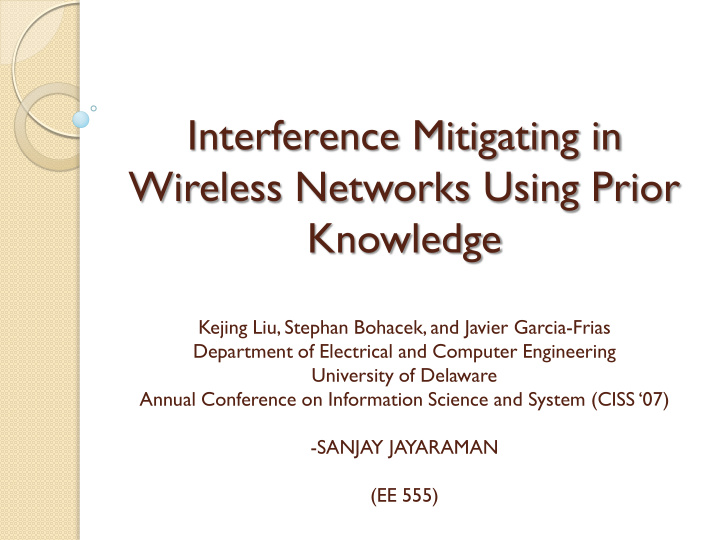



Interference Mitigating in Wireless Networks Using Prior Knowledge Kejing Liu, Stephan Bohacek, and Javier Garcia-Frias Department of Electrical and Computer Engineering University of Delaware Annual Conference on Information Science and System (CISS ‘07 ) -SANJAY JAYARAMAN (EE 555)
Multihop Wireless Networks Multihop Wireless Network (MWN): ◦ A wireless network adopting multihop wireless technology without deployment of wired backhaul links Similar to Mobile Ad hoc Networks (MANET), but ◦ Nodes in MWN is relative ‘fixed’ ◦ MWN may introduce ‘hierarchy’ network architecture
Multihop Wireless Networks T wo categories: ◦ Relay: Tree based topology, one end of the path is the base station Dedicated carrier owned infrastructure ◦ Mesh: Mesh topology, multiple connections among users Routing by carrier owned infrastructure or subscriber equipment
Multihop Wireless Networks Benefit of multi-hop technology ◦ Rapid deployment with lower-cost backhaul ◦ Easy to provide coverage in hard-to-wire areas ◦ Under the right circumstances, it may Extend coverage due to multi-hop forwarding Enhance throughput due to shorter hops Extend battery life due to lower power transmission Price paid ◦ Routing complexity ◦ Path management ◦ Extra delay due to multihop relaying
Objective Framework to mitigate interference in high data rate mobile wirelesss networking. Multihop wireless networking. Correlation with previous available data in the decoding process. Problem is interpreted as one of the transmission over multiple access channel with prior information.
Introduction
Introduction (Contd.)
Introduction (Contd) T wo decoding schemes to improve performance ◦ Interference aware decoding Statistics of interference are different from noise. ◦ Interference mitigating decoding Correlation existing between interference and previously available data to achieve improved performance.
String T opology
String T opology (Contd) Signal received by node N ◦ Y = a -3 X k+l + X k + a 1 X k-1 + Z. Behavior of node 3 ◦ time-slot 1: Y 1 = a -3 X 1 + Z 1 ◦ time-slot 3: Y 3 = a -3 X 2 + X 1 + Z 3 Y 5 = a -3 X 3 + X 2 + a 1 X 1 + Z 5 ◦ time-slot 5: Y 7 = a -3 X 4 + X 3 + a 1 X 2 + Z 7 . ◦ time-slot 7:
String T opology (Contd) Interference aware decoding ◦ During time slot 3, interference a -3 X 2 is not noise but data transmission. ◦ Multiple access decoding with two users allows U 1 to be decoded in the presence of a -3 x 2 .
String T opology (Contd) Interference mitigating decoding ◦ 2 steps are taken First, during time- slot 1, node 3‘s estimate of U 1 is denoted U 1 . This estimate is based on the perhaps weak signal a -3 X 1 . Next, during time-slot 3, node 3 makes a second estimate of U 1 , we denote this estimate as U 1 .
String T opology (Contd)
Star T opology
Star topology (Contd) 1 st time slot ◦ Y 1 A =X 1 +Z 1 A ◦ Y 1 B =X 1 +Z 1 B ◦ Y 1 C =X 1 +Z 1 C ◦ Y 1 D =X 1 +Z 1 D 2 nd time slot ◦ Y 2 B =X 2 +aX 1 +Z 2 B ◦ Y 2 C =X 2 +bX 1 +Z 2 C ◦ Y 2 D =X 2 +bX 1 +Z 2 D
Star T opology (Contd) Interference aware decoding ◦ Interference during time slot 5 is not noise but data transmission. ◦ Mulitple access decoding allows U 5 to be decoded in the presence of bX 4 .
Star T opology (Contd) Interference mitigating decoding ◦ 3 steps are taken During timeslot 3, node A's estimate of U 3 is denoted U 3 ’. Next, during time-slot 4, node A uses U 3 ’ as a prior information to obtain an estimate of U 4 , denoted as U 4 ’. Again, during time-slot 5, node A makes use of U 4 ’ to obtain the estimate of U 5 .
Star T opology (Contd)
Simulation Results (String)
Simulation Results (String)
Simulation Results (Star)
Conclusion and Future Work Both interference aware decoding and interference mitigating decoding perform better than traditional decoding schemes. Model can be extended to complicated environment with multiple neighboring nodes with prior information.
Recommend
More recommend